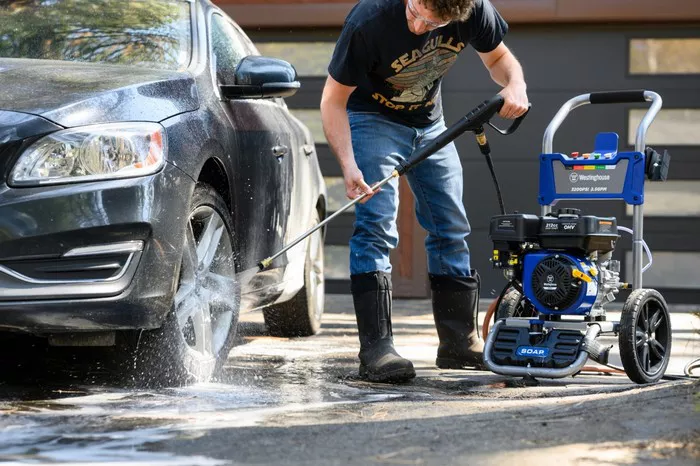A pressure washer is a powerful tool used for cleaning surfaces by directing high-pressure water jets to remove dirt, grime, mold, and debris. One of the most critical components of a pressure washer is its pump, which determines its efficiency, durability, and overall performance. Choosing the right pump type is essential for ensuring optimal functionality and longevity.
In this article, we will explore the different types of pressure washer pumps, their working principles, advantages, disadvantages, and applications. By the end, you will have a clear understanding of which pump type best suits your needs.
Understanding the Basics of a Pressure Washer Pump
A pressure washer pump is responsible for drawing water from a source and increasing its pressure before expelling it through the nozzle. The pump’s efficiency determines the water flow rate (measured in gallons per minute, GPM) and pressure (measured in pounds per square inch, PSI). These two factors influence how effective a pressure washer is for different cleaning tasks.
The main types of pressure washer pumps include:
- Wobble Plate Pumps
- Axial Cam Pumps
- Triplex Plunger Pumps
Each of these pumps has unique characteristics, advantages, and disadvantages that make them suitable for specific applications.
1. Wobble Plate Pumps
Working Principle
A wobble plate pump operates using a wobble plate mechanism to create reciprocating motion in pistons. The plate moves in a circular motion, pushing pistons back and forth to draw in and expel water.
Advantages
- Cost-effective: These pumps are among the cheapest options available.
- Self-priming: They can operate without requiring additional priming.
- Compact and lightweight: Suitable for residential applications where portability is a concern.
Disadvantages
- Lower efficiency: Wobble plate pumps generate significant friction, leading to energy loss.
- Limited pressure range: Typically max out at around 2,500 PSI, making them unsuitable for heavy-duty applications.
- Non-repairable: These pumps are sealed units, meaning they must be replaced entirely if damaged.
Best Applications
- Light-duty residential cleaning tasks (e.g., washing cars, patios, and small decks).
- Occasional users who do not require long operational hours.
2. Axial Cam Pumps
Working Principle
Axial cam pumps use a swashplate mechanism to drive pistons in a back-and-forth motion, pressurizing the water. The cam angle determines how much pressure is generated.
Advantages
- More durable than wobble plate pumps: Lower friction results in improved longevity.
- Higher pressure capability: Can generate up to 3,000 PSI, making them more powerful.
- Compact design: Suitable for mid-range residential and commercial applications.
Disadvantages
- Moderate lifespan: Axial cam pumps wear out faster than triplex pumps but last longer than wobble plate pumps.
- Limited repairability: While some models allow for minor repairs, most are designed to be replaced after a certain period.
Best Applications
- Medium-duty cleaning jobs (e.g., cleaning driveways, fences, and home exteriors).
- Homeowners who require moderate usage of their pressure washer.
3. Triplex Plunger Pumps
Working Principle
Triplex plunger pumps utilize three plungers moving in a synchronized motion to generate high pressure. These pumps operate efficiently by reducing friction and wear.
Advantages
- Highest durability: Made from high-quality materials such as stainless steel and brass, ensuring long operational life.
- Superior efficiency: Capable of achieving pressures up to 4,000 PSI or more.
- Repairable: Unlike wobble plate and axial cam pumps, triplex pumps can be maintained and repaired, extending their lifespan.
- Smooth operation: They provide consistent pressure with minimal pulsation.
Disadvantages
- Higher cost: Triplex pumps are the most expensive option.
- Requires regular maintenance: To keep them running efficiently, users must perform routine maintenance, such as checking seals and lubricating components.
Best Applications
- Commercial and industrial cleaning (e.g., construction sites, heavy equipment, and large surfaces).
- Professional power washing services.
- Heavy-duty residential cleaning needs.
How to Choose the Best Pressure Washer Pump for Your Needs
1. Determine Your Cleaning Requirements
- If you need a pressure washer for occasional home use (e.g., washing cars and garden furniture), a wobble plate pump is sufficient.
- For frequent home use with moderate cleaning needs, an axial cam pump provides a balance between performance and cost.
- If you need professional-grade cleaning for commercial or industrial applications, a triplex plunger pump is the best option.
2. Consider Your Budget
- Wobble plate pumps are the cheapest but require replacement once worn out.
- Axial cam pumps are a middle-ground option with better durability.
- Triplex plunger pumps have a higher upfront cost but last much longer with proper maintenance.
3. Check for Repairability
- If you want a pressure washer that lasts for years, choose a model with a triplex plunger pump, as it can be repaired instead of replaced.
4. Look at Water Flow Rate (GPM)
- Higher GPM ratings indicate faster cleaning times.
- For most home uses, 1.5–2.5 GPM is sufficient.
- For commercial applications, 3.0+ GPM is recommended.
Conclusion
Investing in the right pressure washer pump ensures better cleaning performance, longer lifespan, and overall cost-effectiveness. Before making a purchase, consider how often you will use your pressure washer, the type of surfaces you need to clean, and whether long-term repairability is a priority.

